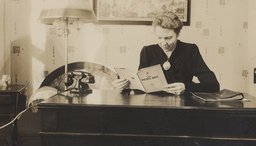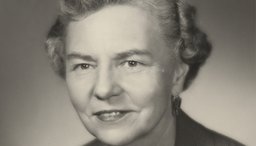
A TRAILBLAZER
Mildred was one of those rare individuals whom a person is fortunate to know perhaps only once in a lifetime. All who knew her agreed there was no one else in the world like her.
Mildred Westervelt Warner was the President and CEO of Gulf States Paper Corporation for 20 years between 1938 and 1957, and led the company in everything but title for ten years prior to officially assuming the top spot. She was the only female CEO of a major integrated paper company decades before it was common to see women in the Executive ranks of major companies. Her sensational career in the paper industry was well known to industrialists throughout the nation for decades. As a result of her courage, determination and vision, the company she led survived the country’s worst economic depression and the world’s worst war, and is still prospering today.
Her accomplishments weren’t solely in the business world, however. She was a devoted mother and friend; a keen businesswoman and politician; a generous caregiver and benefactor; an involved citizen and community leader; and a trailblazing pioneer. Long before it was common to find women in executive business positions in the United Stated, Mildred proved that it was possible to balance the roles of homemaker and mother, community worker and industrial executive.
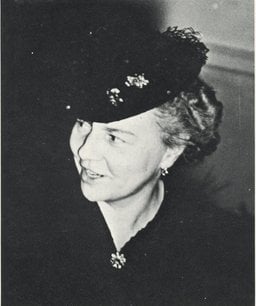
Mildred was known for her generosity, warmth, wisdom, and wit. Her great passions in life included: family, faith, community, industry and conservation.
In 1974, upon her passing, a newspaper wrote: “A great and regal lady, Mrs. Warner was also a pioneer and leader among businesswomen. She manifested to a far greater degree the place of women in industrial, business and political roles than been matched by anyone since”
EARLY LIFE
From her father, Mildred inherited a balanced sense of values, a strong feeling of stewardship, unfailing patience and unflinching courage.
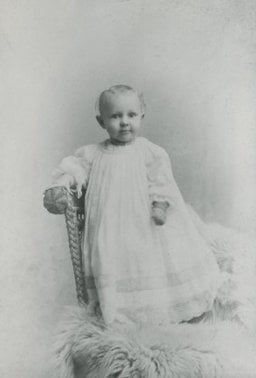
Mildred Grace Westervelt was born on July 2nd, 1893, in Mechanicsville, New York, at her mother’s family home near the Hudson River. Residential electricity was unheard of at the time, leading to what was called a “Lamp lit, blessed event.”
Her father was the son of a Congregational minister. Her grandmother was of the first female students to attend Oberlin college – Oberlin college was the first coeducational college in the United States and is the second oldest operating coeducational institute of higher learning in the world.
When Mildred, was a year old, the family moved to South Bend, Indiana where her father, Herbert Eugene Westervelt ran the paper bag business he founded in 1884 – the business that is now known as The Westervelt Company.
- The family all claimed that she was a happy and beautiful baby though Mildred later said the family may have been biased since she was the first grandchild
- Later in life, upon going through family archives, Mildred wrote that she found a photograph that showed her with blonde curls, clasped hands and eyes lifted heavenward where she looked to “angelic to live long” and that all too soon, her curls were cut, her hands were too busy to stay clasped and she found it necessary to look ahead to the future of the family business
- Later in life Mildred often joked that her kinfolk were fond of telling her how “beautiful” she “USED to be”
Mildred began grade school in 1901 at the age of 8 and graduated from South Bend High School 8 years later in 1909 at the age of 16. Growing up, Mildred suffered from a childhood illness that kept her at home outside of school hours and presented her from active play. As a result she spent a lot of time with adults and specifically with her father which resulted in her developing a keen interest in business.
Because there were no sons, and her sister, Helene, was less interested in business, Mildred and her father were inseparable and frequently spent their time discussing business ideas and ideals. Mildred later wrote “I learned about straw paper with my ABCs and was familiar with dimensions and diversities of square and E-Z Opener bags long before I started measuring parallelograms in geometry”.
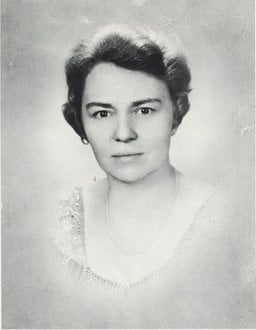
As a youth, editorials and business news were her interests in newspapers and magazines. Mildred later confessed to friends that she loved to “horn in” on men’s conversations when she was a child because they talked on subjects which interested and stimulated her.
Following high school, she enrolled in Lasell Junior College near Boston where she studied accounting and business law. She graduated two years later, then took a tour of Asia before returning to South Bend, Indiana where she intended to enroll in a university.
MARRIAGE TO HERB WARNER
Mildred and Herb Warner worked as a team. She carried the banner for others to follow, while he led financial and legal areas of business.
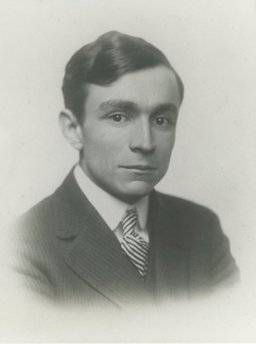
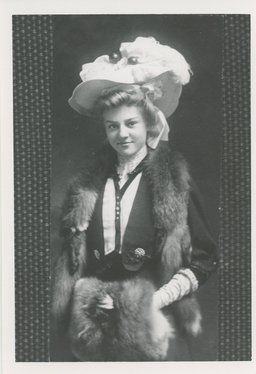
Her university plans changed when she met Herbert David Warner at a meeting of the South Bend Community Chest, a counterpart to today’s United Way. Three weeks later they were engaged and instead of enrolling in a University to continue her education as planned, Mildred decided to return to Lasell for a special course in domestic science.
The coupled married on July 17, 1915 at Mildred’s parents home in South Bend, Indiana. In October of the same year, both Mildred and David joined her father’s company.
THE FAMILY BUSINESS
Herbert Westervelt wrote that he had great confidence in his new executives - faith in his daughter's ability to take the reins and in his son's in law expertise as secretary-treasurer.
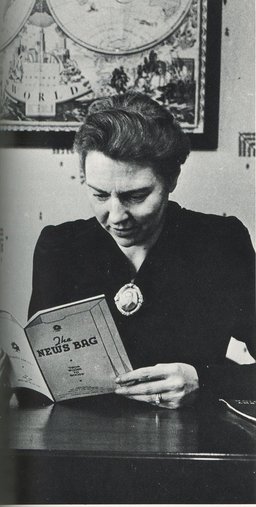
The foundations of the southern pulp and paper industry were laid between 1900 and 1930. The mills that pioneered in the first twenty years of this period found that they could operate successfully by using the sulphate process to make marketable paper from Southern pine. The increasing demand for kraft products caused paper manufacturers to seek new sources of raw materials because of dwindling Northern wood supplies. The South’s abundance of wood, power, labor and water, and its proximity to markets were attractive to papermakers. These advantages, coupled with technological developments occurring in this era, caused a general expansion in Southern pulp and paper in the 1920’s. Several large concerns, including Gulf States Paper Corporation contributed to this rapid rise. By 1930, there were fifteen major Southern kraft mills and the region accounted for over 50 percent of the nations pulp production.
- In 1917, Mildred and H.D. moved to Decatur, IL to head production and financial responsibilities
- In 1928, Hebert Westervelt entered semi-retirement, and at the age of 35, Mildred Westervelt Warner was promoted to Executive Vice-President. HD became Secretary Treasurer.
- Construction of Tuscaloosa, Ala., mill began in June of 1928
FAMILY LIFE
Mildred derived much pleasure from all three areas of her life - making a home for her family, participating in church and community projects and solving business problems as an executive.
Home was a place where friends and family loved to gather, the welcome as warm as the rooms were beautiful. The gracious Warner home in Tuscaloosa was filled with furniture and decorative pieces she enjoyed collecting from far and wide.
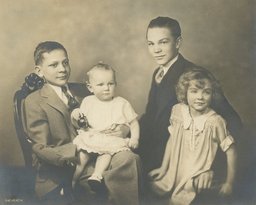
Her children were:
- David Warner born in spring of 1916
- Jonathan “Jack” Westervelt Warner born on July 28, 1917
- Joan born in 1926
- Helene born December 1929
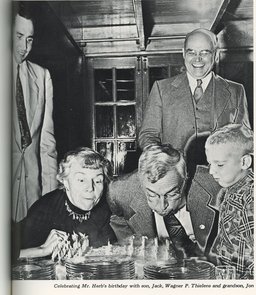
The family took a special interest in providing resources for teaching children to swim, following a tragedy in 1931. Mildred spent much of her life building facilities and funding programs for children throughout the state.

LEADING THE COMPANY
Mildred possessed a keen business sense combined with a heartfelt concern for people.
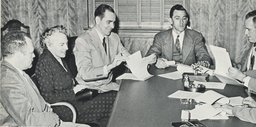
In 1938, upon the officially retirement of her father, Mildred was appointed President and CEO though she had essentially served in that role in all but title since 1929. Mildred achieved much as an executive leader. She was one of the first women in the United States to head a large forest products corporation, and she did so at during some of the most turbulent periods in American history. She was said to have been an amazing leader and clearly she had the courage, intellect and mental fortitude to lead the company through the turbulent years of not only the Great Depression but later World War II.
It was said that had a keen business sense that was combined with a heartfelt concern for people. An employee later wrote “Most of all Mildred inspired love, unity, and loyalty in all who came to know her in the various realms of her busy life, making her leadership effective and successful. She was convinced that all things done in life should not only be worthwhile, but should be fun, including business”.
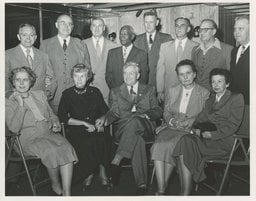
SIGNIFICANT ACHIEVEMENTS
Mildred sealed her position as the first female titan of industry in the paper markets.
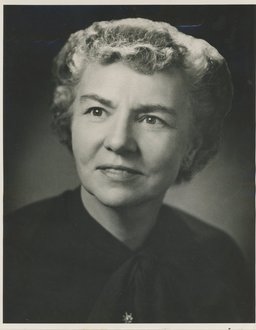
- In 1928, Mildred oversaw the construction of the Tuscaloosa Paper Plant and the consolidation and migration of all other U.S. operations into Tuscaloosa.
- In the 1930’s she created a professional forestry organization to handle the forestry affairs of Gulf States.
- In 1948, Mildred developed the plans for and oversaw the expansion of the Tuscaloosa plant, almost doubling plant capacity.
- Also in 1948, she guided development of a program in which company foresters advised Alabama private landowners in developing sound forestry conservation practices.
- In the early 1950's she developed the mill at Demopolis, which marked the first installation in the paper industry of a continuous digester for making bleached market pulp.
- In 1953, she established the Westervelt Game Preserve, a 12,000 acre working wild life sanctuary in Pickens County, Alabama where eastern turkey and white tail deer would be reestablished after years of overhunting in the area.
- In 1956, she was instrumental in employing the first corporate specialist in wildlife management in the South to ensure the company’s operations didn’t negatively impact wildlife. This specialist advised in the development of an overall game management program, which was widely copied for years.
- Throughout her career she grew the company’s timberland holdings from 0 acres when she assumed the CEO role to more than 330,000 acres when she retired in 1957.
RECOGNITION AND AWARDS
- Honorary Doctor of Law Degree – University of Alabama (1956)
- Woman of Achievement Award – Tuscaloosa Business and Professional Women’s Club
- Alabama Business Hall of Fame (1974)
- First Citizen of the Year – Tuscaloosa Civitan Club (1974)
- Alabama Women’s Hall of Fame (1984)
- Tuscaloosa County Civic Hall of Fame (2002)
HER OWN WORDS
Service must come before profit in successful industry.
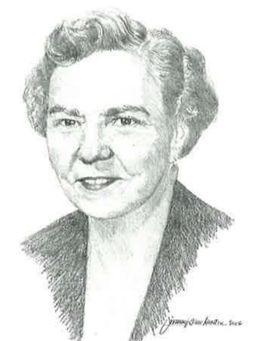
In 1938 when asked by the editor of the company newsletter, the News Bag, what business meant to her, Mildred penned the following:
“Industry means so much more to me than just the success of our company. It means the basic desire and determination to serve humanity – to make the best possible product, at the least possible cost (after ensuring good wages and working conditions); and to sell this quality product at the lowest reasonable price, after a fair return to the stockholder, and the vital “nest-egg” for plant repairs, upkeep and modernization.
This can only be accomplished by confidence: confidence between manufacturer and public, between management and employee, between citizen and government. Such confidence can only be built on honest dealing, with full knowledge of facts.
The conception of business is the objective of service and it is this principle upon which I depend to guide me through the perils and pitfalls that threaten the leader of any enterprise”
The following year in the February 1939 edition of the News Bag, she wrote:
Some months ago, at a group discussion, this question was suddenly raised:
“What is the PURPOSE of the Gulf States Paper Corporation?”
Then the fun began. It sounded easy, but none of us seemed to exactly know; or at least we couldn’t put it into words. Someone blurted out “PROFITS!” Everybody laughed, though they probably had the same idea themselves.
We all know that if any company goes too long without profits it just keeps right on going-going-until it is GONE! But we also know that we would not want to work for the Gulf States Paper Corporation, or any other company, were its major purpose the accumulation of profits at any cost.
SERVICE must come before PROFIT in successful industry, just as much as in science or the professions.
How we would hate to have our doctor treat us with his attention entirely centered on the prospective fee. Of course, he might try to keep us alive as an incentive to future fees – but, on the other hand, he might keep us sick for the same reason.
“Profits” could not be the predominant motive of any concern that has stayed in business over fifty years.
After deep thought, another suggestion came forth that our purpose might be “to make quality paper and bags.” “Quality counts” – but it cannot stand by itself. It must be guarded by good management, with a background of workmanship, and a foreground of salesmanship.
Our group never did attain a satisfactory statement of the purpose of GSPC. We agreed the question would furnish any of us with plenty of “food for thought.”
RETIREMENT AND LATER LIFE
Mildred devoted her energies to philanthropy
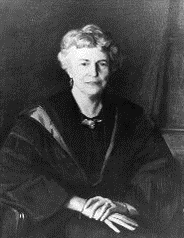
After her retirement as president in 1957, Mildred served Gulf States for two years as Chairman of the Board. In her retirement, Mildred devoted her time and effort to her community. Churches, educational institutions, libraries, orphanages, YMCAs and scouting were among those who benefited from her generosity. She was also deeply interested in the preservation of old structures and was raised with a strong pride in the American story of progress.
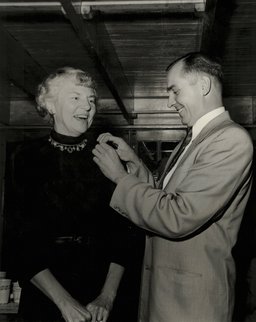
Her artistic touch is evident, too, in the beautifully appointed sanctuary of her church, which she generously served in many capacities. Other lasting relics of her legacy of philanthropy are commemorated in the Mildred Westervelt Warner Transportation Museum, which is located inside one of many old public pool and bath houses that she and Herb built for children across the state.
Mildred Westervelt Warner died on March 12th, 1974 at the age of 80 in Tuscaloosa, Alabama.
Mildred Westervelt Warner’s life touched many people. Upon her passing, the company and family received hundreds of letters from employees, customers, competitors, and citizens. It was clear that she impacted the lives of many in positive and lasting ways.
A former employee wrote of her life - “In remembering Mildred Westervelt Warner, many different things can be said, and all of them are good. But most of all she’ll be remembered as a gracious lady who called you by name, shook your hand, asked about your family, and was sincerely glad to see you”.

